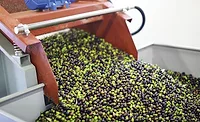Field Report
The doughnut store that is a shop floor
Krispy Kreme uses Siemens drives and controls integrated by Think PLC automation consultants, making each store a high-tech doughnut manufacturing facility.
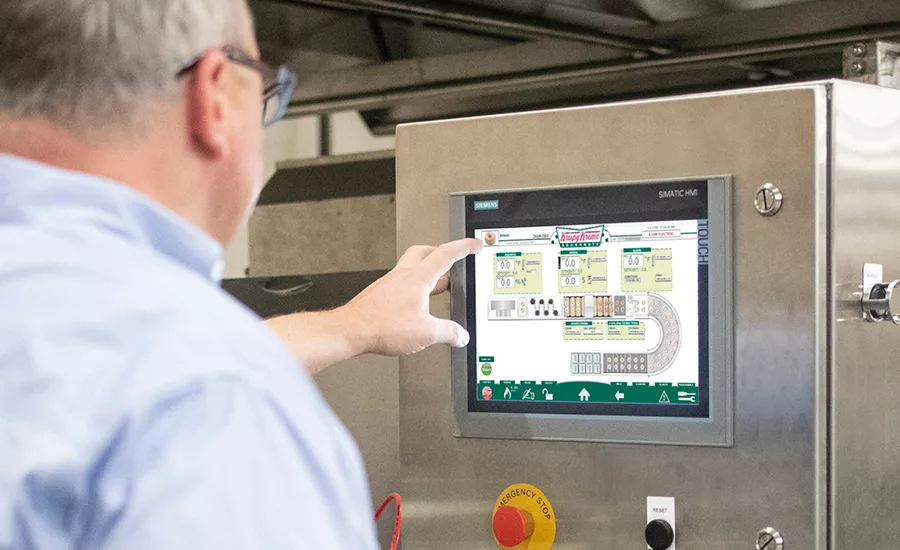
Each Krispy Kreme store can produce 1,000 dozen doughnuts per hour. Pump motor drive performance in the store can be seen through the Siemens TIA portal to diagnose, troubleshoot, maintain and prevent disruptions to production flow. Photos courtesy of Siemens
From its early beginnings, the Krispy Kreme company has designed and built the proprietary machines that have given “rise” to their equally safeguarded doughnut recipe. The quality and consistency of the global doughnut brand starts at the company’s headquarters in Winston-Salem, N.C., where a 105,000 sq.-ft. manufacturing facility houses research, design, testing, engineering and production.
The machines and processing equipment being built there use Siemens drives and controls, collaboratively integrated by Think PLC, the automation engineering partner to Krispy Kreme.
Every Krispy Kreme store is a high-tech doughnut manufacturing facility. Throughout the process, the shortening is kept within an exact range of temperature. Doughnuts are cooked on both sides for a precise number of seconds on each side. The cooling conveyor cycles through the store at a set number of minutes.
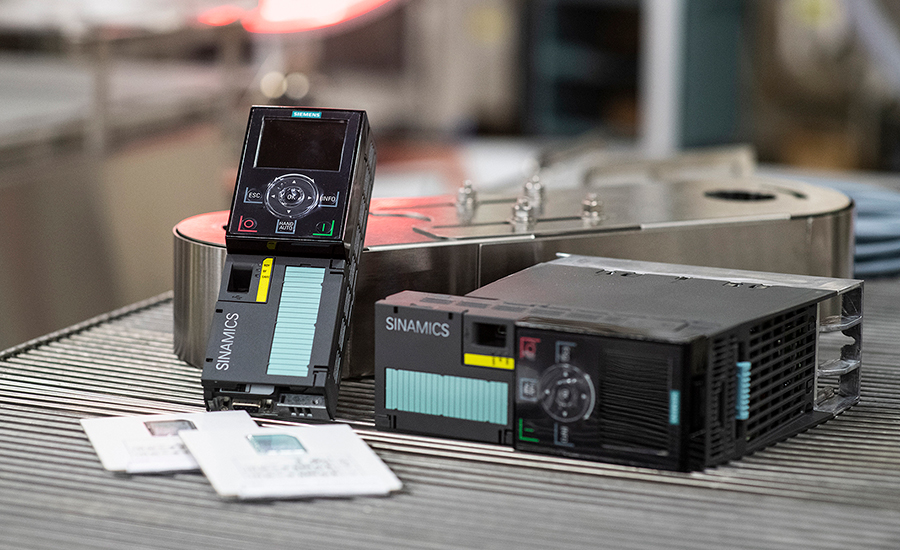
Driving shop-floor automation
Patrick Betson, Krispy Kreme’s director of equipment manufacturing, is responsible for the machine-building side of the business. He has long understood the connection between the making of great machines and the making of great doughnuts. Having gathered insights from the company’s service technicians, store managers and customers, Betson initiated many improvements leading to increased uptime and mean time between failure. Those early strides pointed to the need for the latest drive technology, related software conversions and safety integration.
“Before there was much publicity about Industry 4.0 and IoT, Bobby Cole (president of Think PLC) and I often talked about the data that could be generated by more advanced machine monitoring,” says Betson. “It became increasingly clear that by integrating the latest Siemens drives and controls on our machines and connecting them using Profinet communications, we could start putting that data to work.”
Krispy Kreme’s decision to use Siemens control automation would support an aggressive rollout of new stores and the swift retrofitting of existing stores. Integrating the latest Siemens variable frequency drive (VFD) technology was an easy decision. The hard part would be to figure out how to conduct those retrofits in the shortest and most cost-efficient way, in over 600 stores worldwide.
That’s when Betson and Cole came up with the idea of a retrofit kit, one that would enable every store to quickly add new components and software to existing hardware, making massive technology conversion acceptable to all, and therefore actionable in short order.
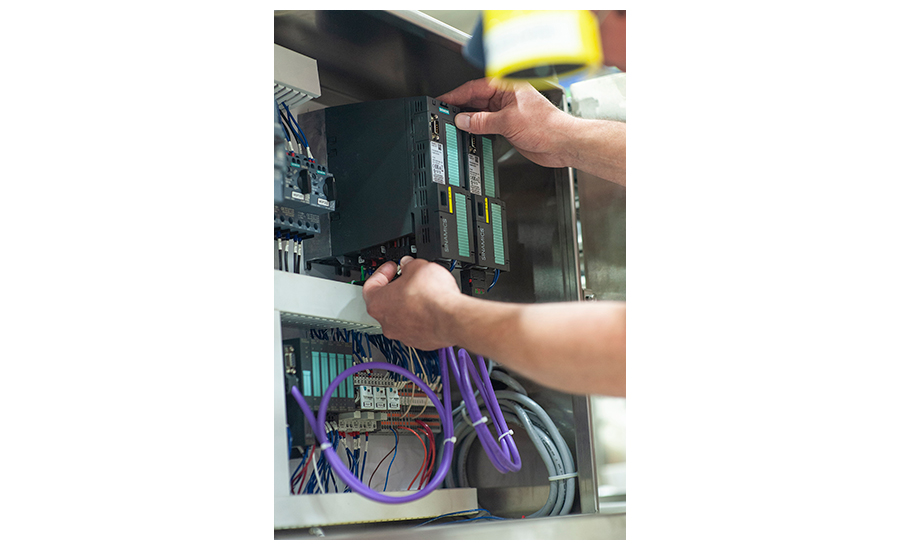
Rapid retrofitting kits
Cole says the concept of a kit was inspired by the realization that, while the Siemens drives and controls installed around 2001 were starting show their age, they all shared a farsighted onboard feature: an SD card. This would prove to be a time-saving, cost-cutting advantage, because the SD cards in the older Siemens drives and PLCs have been maintained to match each store’s unique set of machining and processing parameters.
In addition, each kit would include all that was needed for a local contractor to upgrade the legacy control panels, including parts for safety and power wiring. A bill of material having 15 parts would be reduced to seven. This would mean fewer parts to wear, troubleshoot and stock in the future.
“The main purpose of the kit was to replace the older Siemens Micromaster drives with their SINAMICS G120 drives,” Cole explains. “The SD card in the kit has software that we modified, and with a couple flips of some switches, the drive is automatically programmed. Someone with absolutely no control experience can reload the new software into the new drives and the new PLCs.”
To prove the retrofit kit concept, Krispy Kreme and Think PLC tested the kit’s installation and use in the manufacturing plant in Winston-Salem, followed by tests at various stores in the region. The new drives and PLCs installed smoothly. Their SD cards automatically updated and matched all previous store parameters. After two months, the stores reported the trial a success. To further test the concept themselves, Cole and Betson made a whirlwind trip to retrofit with the kits every store in Australia in over five days.
The retrofit kit concept worked—it enables a store to replace its drives and controls in about two hours. This compared to the hours invoiced by a control technician to travel to a Krispy Kreme store to do the same. A time/cost difference that would be even greater, if the SD card weren’t a feature of the Siemens drives and PLCS, Cole says.
Shortening the adoption curve
During the doughnut frying process, the efficient pumping of heated shortening is critical to maintaining optimal doughnut quality and product count. When the flow rate is not at the desired constant, the wide range of viscosity becomes a problem. The melted shortening will not be filtered of dough bits and pieces. Temperature variances will soon occur, causing hot spots at any point in the frying process, including inside the fryer vat itself.
Behind the scenes, the Siemens SINAMICS G120 drive addresses all of these pump motor concerns, while visually reporting the operational status of each motor. Moreover, the drive is working to assure that all of the pump motors are keeping their cool, below the threshold for heat damage.
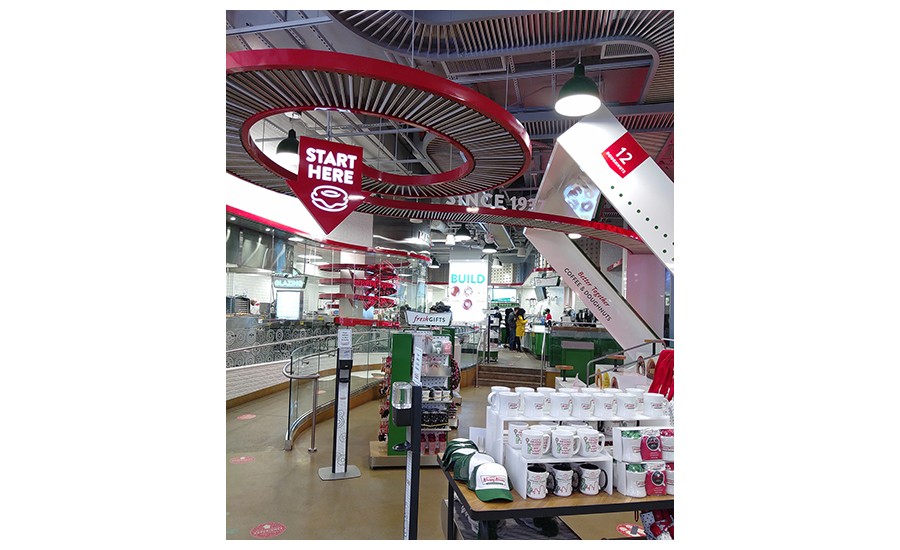
In many pumping applications, motor overheating is probably the number-one service issue, Cole says. That problem is being removed by the drive’s ability to set and hold a curve that assures the most efficient flow, at a low speed and at a high speed, from 7 hertz to 90 hertz. The accuracy of the fry time is also being increased by 12%, resulting in a more consistent product with less waste yield.
“A big advantage of the drive is that it can run a motor slow without the usual rise in motor temp,” Cole says. “When you run a motor at very low hertz, it generates a lot of eddy current. It gets so hot, that you can’t touch the motor. And when you overheat the laminations of a motor, you greatly decrease the life of the motor. But we can monitor each drive through the Siemens TIA (Totally Integrated Automation) portal. We’ve seen the amperage reduced by almost 17%, and the temperature of the motor reduced by 34%. We expect this will more than double the life expectancy of every pump.”
Remote monitoring
The successful grand opening of the Krispy Kreme store in New York’s Times Square was not without the occasional behind-the-scenes drama for new store commissioning. A sudden pumping issue, it was the kind of problem that can happen at any hour, at any of the 500-plus global stores owned by the company. But it is also a concern that can be quickly solved on-site—or from thousands of miles away.
“The situation was addressed in a matter of minutes,” says Cole. “I just went online through the Siemens secure TIA portal to see what the Siemens G-120 drive was showing me. While setting up one of the machines, a motor had been miswired. I could quickly tell the local setup contractor where to look.”
Cole likens the TIA portal experience to standing in the store at the drive’s operator interface. When you open the door to the drive, a large display presents any fault messages. Select a fault message and you are given the related fault code that you would in the past need to look up in the user’s manual. Now, all of the information you need, the details, what to check, how to reset, are on the display. Diagnostic screens help you debug the problem. And beyond this, faults and alarms can be data logged in the cloud. Trends can be studied over the course of a year. Faults for a particular machine can be identified and addressed. A shortening pump that is tripping more often can be replaced during the store’s next on-site inspection.
“I can, on my mobile phone right now, pull up a store in another country,” Cole says. “I can look at how many cuts were made on the extruder today. I can look at how many faults occurred throughout the day on that machine. I can see what the average temperature was in the shortening tank. I can call the local service manager and say, ‘Hey, next time you do a preventative maintenance at that store, you need to send a new pump motor, because you’re getting multiple faults within a short period of time. Have those parts on your truck and you won’t need to make a second trip.’”
Portal to the future
Betson sees the big picture that is being made clear by the data now starting to flow through the Siemens TIA portal. Along with the ability to remotely use each store’s data to plan for machine maintenance and prevention, the data can routinely be studied to measure and improve the design of the company’s machines and processes.
Having anticipated the emergence of Industry 4.0 and IoT, he now also sees how data can be used to guide employee training and best practices for human-machine interaction. Continuous improvement and operational excellence can be studiously amplified store-wide and in stores worldwide.
“The data we are capturing now and hereafter strengthens us in many ways,” Betson says. “It’s important to us as a machine builder, because it also reinforces our culture and Krispy Kreme’s identity in our global marketplace.”
Looking for a reprint of this article?
From high-res PDFs to custom plaques, order your copy today!




